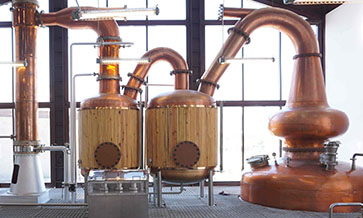The last few years have seen a flurry of action. There are now drinks brands that are forward-integrating into the on-trade, and in some cases into retail, and vice versa. In particular, micro-breweries such as Arbor, Red Rhino and Geist are moving into package retail with their cans.
Bira 91 has launched at least two taprooms, and companies like AB InBev have launched 7 Rivers beers in cans. In spirits, we have Stranger&Sons collaborating with Bombay Canteen for Perry Road Peru; and Diageo setting up the RCB Bar and Cafe in Bengaluru. Vikram posed the question: could these be capital-intensive and possibly risky diversification tactics?
Nagabhiram said the Bira 91 taprooms are the result of consumer patterns and preferences evolving very fast. “We felt this was one opportunity to present all our innovations to our beer lovers, first-hand and in quick time.”
He gave examples of Mango Lassi and Coconut Brown Ale, which emerged after several iterations. “It started off as a pilot. It was successful. Now we are clear that we want to take it to the national scale,” he added.
To Vikram’s question on taprooms emerging as a separate revenue and profit centre for the company, Naga said, “In fact, the first unit has already been positive and has started contributing to the bottom line of our organisation. It’s a fairly sustainable marketing investment.”
Bar DNA
A brand’s DNA is created very successfully in the packaged goods environment. But the DNA of a great watering hole is different, Vikram noted. What exactly is the pulse these brands, which are trying to cross over, should capture?
Shatbhi explained, “They need to understand that a guy drinking at home and a guy drinking in a bar are two different people. When people go out they’re looking for an experience. They’re looking for ambience, great service and good food… If a bar can get all of that together there’s no reason why it wouldn’t succeed.”
Minakshi had another perspective. It’s every brand’s dream to have its own on-trade space, an entrée. “Every brand would want to be where I am because I am also completely influencing my consumers. We are trend-watching on a day-to-day basis; and every brand would want to watch that space, and why not?”
What about cocktail bars across India launching cocktail mixers for home consumption and the challenge from ready-to-drink packaged products? For Minakshi, it has always been on Sidecar’s radar. “But it’ll be foolhardy for me to launch it all by myself. I’ll need the right partners, who understand modern retail.”
According to Shatbhi, some talented mixologists are already making great products and getting into the RTD market. So far as conflict of interest is concerned, she points out how guest shifts and bar take-overs are an indication of increasing collaboration in the years to come.
Naga feels Bira cannot ride on its innovative beers alone. “We realised in our first pilot that a bar experience, a comprehensive 360-degree experience, is what our consumers wanted. That is where the coming together of our beer, cocktails and food happened.”
Retail experience
From the retail perspective, what are the best practices in brand merchandising? Vishal noted that organised retail across all industries has forward and backward integration aimed at overall reduction in cost. “But in the alcobev sector, retail decisions are the products of impulse,” he added.
“There is space for everybody. People who look for a higher experiential form will walk into stores that offer brand discovery. But on an everyday basis, you will pick up what you want from the store nearest to you,” he remarked.
Is it easier for an on- and off-trade outlet to start its own brand? Or for an established brand to venture into the on-trade or retail?
Shatbhi thought it would be easier for established spirit brands to enter the on-trade simply because it has deeper pockets. Minakshi agrees, saying that the kind of capital she would need is not something that she has ready and available.
Naga noted how Japan’s Kirin Asahi is investing in breweries along the US West Coast. “You know there’s a great opportunity, but the important thing is the authenticity and the consistency of one’s brand,” he added.
Vishal had an interesting take on this. “Taking the example of Bira, sometime brands do enter this space not just because the cost of entry is high; sometimes it is the future of the brand which is at stake,” he said.
Bira 91 revolutionised wheat beer across India, including in micro-breweries. “The challenge for them now would be to find the next growth driver in the market. Sometimes these investments go beyond just brand-building; they also grow to find future cash cows. Some brands also enter the on-trade space because it adds to their survival in the long run,” Vishal added.
For the full panel discussion, visit Brews&Spirits Expo on YouTube.
https://www.youtube.com/watch?v=ThIvo1NslEI














